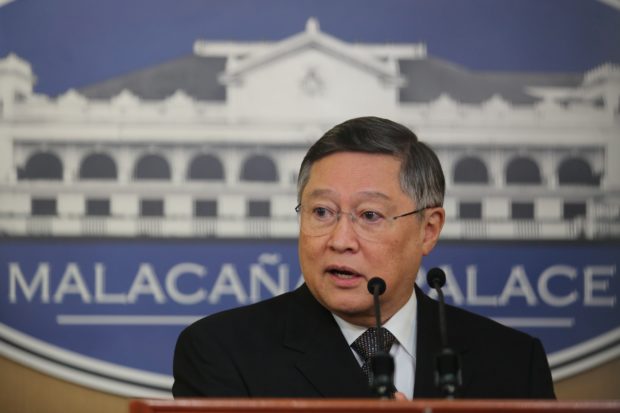China will fund 2 railway projects in Luzon, Mindanao – DOF

Finance Secretary Carlos Dominguez III (Photo by KING RODRIGUEZ / Presidential Photographers Division)
The rollout of two massive railway projects in Central Luzon and Mindanao will be financed by Chinese loans, the Department of Finance (DOF) said Wednesday.
During the Philippine delegation’s courtesy visit last Tuesday to China Vice President Wang Qishan in Beijing, Finance Secretary Carlos G. Dominguez III said that the Philippines and China were “working towards beginning the implementation of two rail projects — the Subic-Clark Railway Project in Luzon and the Mindanao Railway Project.”
The P50.03-billion Subic-Clark Railway Project, which will connect the two freeport zones in Central Luzon, will involve the construction of a total of 71.13-kilometer rail, including a 64.19-km mainline between Clark Freeport Zone and Subic Bay Freeport Zone, as well as a 6.94-km spur line connecting the mainline to the Subic Bay Port New Container Terminal.
The Subic-Clark Railway will have an exclusive right of way (ROW) parallel to the Subic-Clark-Tarlac Expressway (SCTEx).
According to documents from the National Economic and Development Authority (Neda), as of Jan. 31, the construction of the Subic-Clark Railway will start in July this year and will be finished by July 2022.
Article continues after this advertisement“The Chinese side provided the short list of qualified Chinese companies recommended by the Ministry of Commerce on Nov. 1, 2018. The project is in its pre-procurement stage — DOTr [the Department of Transportation] and BCDA [the Bases Conversion and Development Authority] are currently preparing the contract and bidding documents,” Neda said.
Article continues after this advertisementMeanwhile, the P35.26-billion first phase of the Mindanao Railway Project will run on a 102-km non-electrified, single-track rail across the cities of Digos, Davao and Tagum in Davao Region.
The interagency Investment Coordination Committee-Cabinet Committee (ICC-CabCom) approved last October the shift in financing to official development assistance (ODA). The Duterte administration’s previous plan was to build the Digos-Davao-Tagum line using the national budget.
The government want to start implementation of Mindanao Railway phase one this year and aims to have it completed in 2022.
ODA will also finance the second and third phases that will complete the Mindanao Railway loop. Both were “included in the indicative projects proposed for feasibility study assistance by the Chinese government which was submitted to the Chinese embassy in the Philippines on Aug. 20, 2018, and parallel submission to Chinese Ministry of Commerce in Beijing on Aug. 24, 2018,” Neda said.
Besides the two big-ticket railway projects included in the Duterte administration’s ambitious “Build, Build, Build” program, Dominguez said the Davao-Samal Bridge and the Panay-Guimaras-Negros Inter-island Bridge projects were also in the pipeline for possible financing by China.
The P27.16-billion bridge, which will soon to rise in Western Visayas, will involve the construction of a 5.7-km bridge between Panay and Guimaras on top of another 12.3-km bridge between Guimaras and Negros.
Dominguez told Wang that “the funds provided by the Chinese people through the Chinese government are going to be used to the benefit of the Filipino people.”
So far, the Philippines has obtained two US dollar-denominated loans from China — $62.09 million for the P4.37-billion Chico River Pump Irrigation Project and $211.2-million for the P12.2-billion New Centennial Water Source-Kaliwa Dam.
China had also provided a 397-million renminbi or $63.13-million grant to build the P4.61-billion Binondo-Intramuros and P1.37-billion Estrella-Pantaleon bridges crossing Pasig River.
For these four projects, Dominguez said the Philippine government had already “made a lot of progress.” /atm